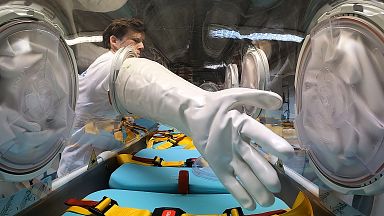Futuris looks at a new Norwegian medical device that can safely transport patients with highly infectious diseases such as Ebola and COVID-19.
Futuris looks at a new Norwegian medical device that can safely transport patients with highly infectious diseases such as Ebola and COVID-19.
Protecting healthcare professionals, while taking care of infected patients to limit the spread of the coronavirus, are just some of the big challenges facing the world right now. An EU project, which merges medical procedure and technology, could help provide the answer.
Oslo based company EpiGuard has developed a specialised medical isolation unit. The EpiShuttle aims to increase safety by reducing risk of infection, while at the same time, allowing medical treatment to take place.
It enables healthcare workers to be in close proximity to a patient - providing care - without fear of contamination.
"What we see now in COVID-19 is that many healthcare professionals also has been infected. So I think it's very important that you are able to feel safe while providing your work and doing your work. And also that you particularly when you're transporting patients, because in an ambulance or in a helicopter, you're sitting very close by the patient," says EpiGuard's CEO, Ellen Andersen.
Inspired by Ebola
The idea to design the medical isolation unit was inspired by the Ebola epidemic between 2014-16 in Sierra Leone. A Norwegian doctor working in the African country was infected and had to be sent home for treatment.
"It’s extremely important that we can treat the patients during transport as if they did not have the infection. So that we have the same options and the same possibility for what kind of treatment that we would give to our patients," explains EpiGuard founder Fridjof Heverdal.
He adds: "We can treat the patient with the intubation of the airways so we can do mechanical ventilation with a hose all the way through the device and up to the patient's mouth. We can do intravenous treatments through intravenous ports. We can monitor the patient very thoroughly with intravenous monitoring or intra-arterial monitoring."
The EpiShuttle can transport patients infected with Ebola, SARS, and MERS, but also other diseases, such as tuberculosis, or infections with multi-resistant bacteria.
One of the unit’s biggest advantages is that vehicles used to transport infectious patients do not need to be disinfected each time after use.
The isolation unit’s design and transparent cover also seek to limit the physical and psychological side effects to patients caused by a long journey in an ambulance or helicopter.
"I would say that we have succeeded to develop a product that the patient can lay inside without getting a claustrophobic feelings and also to be able to lay down and to have rest at the same time with different possibilities to change the position of the bed, so that if there is a long term transportation you may lay down for several hours," says Victor Rosenvinge, from Eker Design.
Along with some hospitals, air forces in Norway, the UK, Denmark, Germany and Belgium are using the isolation unit to transport COVID-19 patients.












